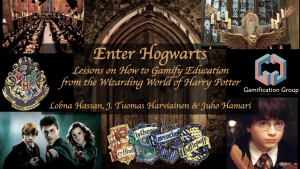ENTER HOGWARTS: LESSONS ON HOW TO GAMIFY EDUCATION FROM THE WIZARDING WORLD OF HARRY POTTER

The first time we entered Hogwarts; the world-class School of Witchcraft and Wizardry was in 1997, in the novel Harry Potter and the Philosopher’s Stone by J. K. Rowling. The first scenes of Hogwarts are of Professors McGonagall and Dumbledore, introducing the new school comers to how Hogwarts is run. As a kid, I was of course fascinated by the school. I had my own set of wizarding robes, magic wands and I impatiently waited for my Hogwarts admission letter. Whether that letter came or not is beside the point. As an all-grown-up gamification researcher; Hogwarts became more fascinating!
Gamification is about designing activities to make them as enjoyable and engaging as games are. This is done through introducing game elements to these activities in question. In education; gamification is about engaging students with learning through designing more engaging schools, syllabuses, classrooms, after-school activities, etc. The outcome from gamification is not necessarily a “game” but the outcome is mainly a gameful activity that is as engaging (enjoyable) as a game is engaging and enjoyable.
Most of gamified education uses elements from games such as points, badges, leaderboards, teams, competition, trophies……… yes I said points and teams!
Hogwarts, throughout the novels and movies is mainly run by dividing students into 4 large teams (houses); Gryffindor, Hufflepuff, Ravenclaw and (the beloved) Slytherin. Every year, students belonging to these houses compete on who can win the most points for their house so that by the end of the year they can win the Hogwarts house cup.
How is this not gamification!
The study of fiction and Hogwarts, allows us to see the possible positive and negative outcomes from gamification so that gamification designers are at least better aware of the possible outcomes as they design gamification. The study of Hogwarts can help shorten a lengthy cycle of trial and error to gamification design. We can use Hogwarts to expect what gamification would or would not work in real life. Furthermore, there is a large number of people online – like me – who wish to study at Hogwarts and demand real life Hogwarts(s). It appears from this that fiction and pop culture is already influencing our expectations and possibly design practices.
These reasons, overall, made it very important to understand how Hogwarts is designed and run and if we can draw lessons from it on gamified education design.
In 2017; I entered Hogwarts with my co-authors as a researcher. I will spare you the technical details but in summary we employed a textual analysis technique and analysed the first novel in the Harry Potter series: Harry Potter and the Philosopher’s Stone.. We coded instances where gamification can be observed and we anchored that against phycology theory used in gamification design. In summary it was complex and fun!
We identified several overlaps between the design of Hogwarts and popular gamification design practices.
When we looked at the school through the lens of the self-determination, a core psychology theory of motivation in gamification design, Hogwarts did seem to have a design that induces learner engagement. The school clearly uses many of the classical gamification design elements such as competition, collaboration, clear rules, roles, badges, trophies and aesthetics. It is hence very interesting to observe in this fictional school how gamification elements are connected together in a large-scale design.
Expectedly, competition – facilitated by the 4 Hogwarts houses and the point system – does push students to work harder but it also does lead to negative behaviour such as bullying. Competition led to cooperation inside the houses where we see students helping each other perform better so the house can earn more points and win the house cup. Learning goals and outcomes became imbedded in the large, engaging competition But because the points-system of Hogwarts carry in it some subjectivity – for example there are no clear rules for why a student is rewarded with 10 points in one classroom for answering a question right but earns a whooping 50 points in another classroom- , the school maintains regular exams to measure the educational progress of its students. Hogwarts also provides other smaller trophies – next to the house cup – that students (presumably) can earn throughout the year so that they also can feel and showcase their excellence to others in the school.
The presentation of this research was very well received, winning the best presentation award at the 2nd International GamiFIN Conference (GamiFIN2018), Pori, Finland..
The lessons that can be learned from Hogwarts on gamified education and on how pop culture influences our designs and expectations are many. This is only a short summary!
You can find the full discussions here!
Reference: Hassan, L., Harviainen, J. T. & Hamari, J. (2018). Enter Hogwarts: Gamified Education Lessons from the Wizardlings World of Harry Potter. Proceedings of the 2nd International GamiFIN Conference (GamiFIN2018), (pp. 30-39). Pori, Finland,




Sorry, the comment form is closed at this time.